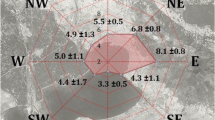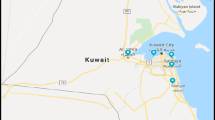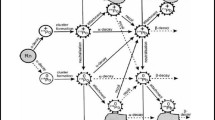Abstract
Airborne radon concentration at any given location is influenced by locally exhaled radon and dispersed radon from other locations. As a means of trying to discriminate between different radon contributors, radon gas, individual radon daughters or progenies, and the equilibrium factor were measured at different receptor points downwind and upwind of a mine tailings storage facility by following the direction of the wind at hourly intervals. The AlphaGUARD PQ2000 PRO model active radon monitor was used to measure radon concentration, and the Eberline SPA-1A alpha scintillation detector coupled to Eberline Smart Portable 2 counter was used to measure the radon daughter concentrations. The Busigin and Phillips three-count method was used to calculate the radon daughter concentrations, and hence the equilibrium factor. The minimum value of equilibrium factor was 0.016 ± 0.012 measured upwind, whereas the maximum value was 0.502 ± 0.044 measured downwind. The results revealed strong influence by external meteorological effects on the distribution of radon and radon daughters some distance from the tailings and background. The equilibrium factor, which indicates the “age” of the gas, and radon gas concentrations, increased to their highest values in the mornings when the wind was blowing from north–north-east direction. The results confirmed that concentrations of radon and its daughters do not remain constant even under same distances from a tailings or same wind speeds. Furthermore, concentration changes by radioactive decay were overshadowed by other factors such as changing wind direction and local conditions of exhalation.







Similar content being viewed by others
References
Akber R, Pfitzner J (1994) Atmospheric concentrations of radon and radon daughters in Jabiru East. Supervising Scientist for The Alligators Region, Canberra
Arnold D, Vargas A, Ortega X (2009) Analysis of outdoor radon progeny concentration measured at the Spanish radioactive aerosol automatic monitoring network. Appl Radiat Isot 67:833–838. https://doi.org/10.1016/j.apradiso.2009.01.042
ATSDR (2012) Toxicological profile for radon. Agency for Toxic Substances and Disease Registry, Atlanta, GA
Baciu AC (2005) Radon and thoron progeny concentration variability in relation to meteorological conditions at Bucharest (Romania). J Environ Radioact 83:171–189. https://doi.org/10.1016/j.jenvrad.2005.02.015
Bateman H (1910) The solution of a system of differential equations occurring in the theory of radioactive transformations. Proc Camb Philos Soc 15:423–427
Bersimbaev RI, Bulgakova O (2015) The health effects of radon and uranium on the population of Kazakhstan. Genes Environ 37:18. https://doi.org/10.1186/s41021-015-0019-3
Blaauboer RO, Smetsers RCGM (1997) Outdoor concentrations of the equilibrium-equivalent decay products of 222Rn in the Netherlands and the effect of meteorological variables. Radiat Prot Dosimet 69:7–18. https://doi.org/10.1093/oxfordjournals.rpd.a031889
Busigin A, Phillips CR (1980) Uncertainties in the measurement of airborne radon daughters. Health Phys 39:943–955. https://doi.org/10.1097/00004032-198012000-00008
Čeliković I, Pantelić G, Vukanac I et al (2022) Outdoor radon as a tool to estimate radon priority areas—a literature overview. Int J Environ Res Public Health 19:662. https://doi.org/10.3390/ijerph19020662
Chambers S, Williams A, Crawford J, Griffiths A (2014) On the use of radon for quantifying the effects of atmospheric stability on urban emissions. Atmos Chem Phys 14:25411–25452. https://doi.org/10.5194/acpd-14-25411-2014
Chen J, Harley NH (2018) A review of indoor and outdoor radon equilibrium factors-part I: 222Rn. Health Phys 115:490–499. https://doi.org/10.1097/HP.0000000000000909
Chen J, Marro L (2011) Assessment of radon equilibrium factor from distribution parameters of simultaneous radon and radon progeny measurements. Radiat Environ Biophys 50:597–601. https://doi.org/10.1007/s00411-011-0375-8
Chen J, Moir D, Whyte J (2012) Canadian population risk of radon induced lung cancer: a re-assessment based on the recent cross-Canada radon survey. Radiat Prot Dosimet 152:9–13. https://doi.org/10.1093/rpd/ncs147
Climate-Data.org (2019) Odendaalsrus climate: Average Temperature, weather by month, Odendaalsrus weather averages - Climate-Data.org. https://en.climate-data.org/africa/south-africa/free-state/odendaalsrus-26385/. Accessed 1 Aug 2019
Darby S, Hill D, Auvinen A et al (2005) Radon in homes and risk of lung cancer: collaborative analysis of individual data from 13 European case-control studies. BMJ 330:223. https://doi.org/10.1136/bmj.38308.477650.63
de Paula VM, de Sá LV, Braz D (2020) Comparative analysis of equipment performance in nuclear medicine. Braz J Radiat Sci 8:993. https://doi.org/10.15392/bjrs.v8i1B.993
Degu Belete G, Alemu Anteneh Y (2021) General overview of radon studies in health hazard perspectives. Journal of Oncology 2021:e6659795. https://doi.org/10.1155/2021/6659795
Deyuan T (1991) Analysis of radon-222 daughters in air. J Radioanal Nucl Chem 154:5–21
Doering C (2019) A new background subtraction method for assessing public radiation exposure due to radon transport from a uranium mine. Radiat Prot Dosimet 186:530–535. https://doi.org/10.1093/rpd/ncz141
Field RW (2018) Radon: a leading environmental cause of lung cancer. afp 98:280–282
Furuta S, Ito K, Ishimori Y (2002) Measurements of radon around closed uranium mines. J Environ Radioact 62:97–114. https://doi.org/10.1016/s0265-931x(01)00154-0
Saphymo GmbH (2012) Portable radon monitor, User Manual
Habib RR, Nuwayhid RY, Hamdan Z et al (2018) Indoor and outdoor radon concentration levels in Lebanon. Health Phys 115:344–353. https://doi.org/10.1097/HP.0000000000000888
Hu SJ, Tan KS (2000) Radon and its progeny in outdoor air. ASEAN J Sci Technol Dev 17:65–70. https://doi.org/10.29037/ajstd.122
IAEA (1991) Quality control of nuclear medicine instruments. International Atomic Energy Agency, Vienna
IARC (1988) Man-made mineral fibres and radon
ICRP (2009) Statement on radon. International Commission on Radiological Protection, Ottawa
JCGM (2008) Evaluation of measurement data—Guide to the expression of uncertainty in measurement. Int Organ Stand Geneva ISBN 50:134
Kang JK, Seo S, Jin YW (2019) Health effects of radon exposure. Yonsei Med J 60:597–603. https://doi.org/10.3349/ymj.2019.60.7.597
Komati FS (2020) Radon dispersion from a south african gold mine-tailings dam—measurement and modelling. Central University of Technology, Bloemfontein, PhD
Kumar KC, Prasad TR, Ratnam MV, Nagaraja K (2016) Activity of radon (222Rn) in the lower atmospheric surface layer of a typical rural site in south India. J Earth Syst Sci 125:1391–1397. https://doi.org/10.1007/s12040-016-0745-3
Leach VA, Chandler WP (1992) Atmospheric dispersion of radon gas and its decay products under stable conditions in arid regions of Australia. Environ Monit Assess 20:1–17. https://doi.org/10.1007/BF00396516
Lindsay R, de Meijer RJ, Joseph AD et al (2004) Measurement of radon exhalation from a gold-mine tailings dam by γ-ray mapping. Radiat Phys Chem 71:797–798. https://doi.org/10.1016/j.radphyschem.2004.04.097
Lindsay R, Newman RT, Speelman WJ (2008) A study of airborne radon levels in Paarl houses (South Africa) and associated source terms, using electret ion chambers and gamma-ray spectrometry. Appl Radiat Isot 66:1611–1614. https://doi.org/10.1016/j.apradiso.2008.01.022
Lubin JH, Wang ZY, Boice JD Jr et al (2004) Risk of lung cancer and residential radon in China: Pooled results of two studies. Int J Cancer 109:132–137. https://doi.org/10.1002/ijc.11683
Maiello ML, Hoover MD (eds) (2010) Radioactive air sampling methods. CRC Press, Boca Raton
Michelin (2022) MICHELIN Kutlwanong map - ViaMichelin. https://www.viamichelin.com/web/Maps/Map-Kutlwanong-9480-Vrystaat-South_Africa. Accessed 3 Aug 2022
Molchanov O, Soroka Yu, Podrezov A et al (2010) Dispersion of radon in the atmosphere around old uranium mill tailings. Nukleonika 55:535–538
Momeni MH, Lindstrom JB, Dungey CE, Kisieleski WE (1979) Radon and radon-daughter concentrations in air in the vicinity of the Anaconda Uranium Mill
Moshupya P, Abiye T, Mouri H et al (2019) Assessment of radon concentration and impact on human health in a region dominated by abandoned gold mine tailings dams: a case from the West Rand region. S Afr Geosci 9:466. https://doi.org/10.3390/geosciences9110466
Neuberger J, Harley N, Kross B (1996) Residential radon exposure and lung cancer: potential for pooled or meta-analysis. J Clean Technol Environ Toxicol Occup Med 5:207–221
Ongori JN, Lindsay R, Newman RT, Maleka PP (2015) Determining the radon exhalation rate from a gold mine tailings dump by measuring the gamma radiation. J Environ Radioact 140:16–24. https://doi.org/10.1016/j.jenvrad.2014.10.012
Podstawczyńska A, Kozak K, Pawlak W, Mazur J (2010) Seasonal and diurnal variation of outdoor radon (222Rn) concentrations in urban and rural area with reference to meteorological conditions. Nukleonika 12:543–547
Porstendörfer J (1994) Properties and behaviour of radon and thoron and their decay products in the air. J Aerosol Sci 25:219–263. https://doi.org/10.1016/0021-8502(94)90077-9
Porstendörfer J, Gründel M (2005) Radon decay products in outdoor air. In: Radioactivity in the Environment. pp 56–65
Pressyanov DS, Guelev MG, Sharkov BG (1995) Radon and radon progeny outdoors in a valley of enhanced natural radioactivity. Atmos Environ 29:3433–3439. https://doi.org/10.1016/1352-2310(95)00204-c
Raviart S, Richon P, Haristoy D et al (1996) Field determination of the time-varying equilibrium factor between 222Rn and its short-lived decay products in the atmosphere above a waste-rock pile. Environ Int 22:279–286. https://doi.org/10.1016/S0160-4120(96)00119-5
Rozas S, Idoeta R, Alegría N, Herranz M (2016) Radiological characterisation and radon equilibrium factor in the outdoor air of a post-industrial urban area. J Environ Radioact 151:126–135. https://doi.org/10.1016/j.jenvrad.2015.09.023
Siaway G, Mose D, Metcalf J (2009) Evaluation of indoor radon potential in northern virginia using spacial autocorrelation. Gis Appl 3D Vis 14:27
Singh K, Singh M, Singh S et al (2005) Variation of radon (222Rn) progeny concentrations in outdoor air as a function of time, temperature and relative humidity. Radiat Meas 39:213–217. https://doi.org/10.1016/j.radmeas.2004.06.015
Song J-M, Kim W-H, Kang C-H et al (2015) Temporal variability of atmospheric radon-222 concentration at Gosan Station, Jeju Island, Korea, during 2009–2013. Bull Korean Chem Soc 36:603–608. https://doi.org/10.1002/bkcs.10118
Speelman WJ (2004) Modelling and measurement of radon diffusion through soil for application on mine tailings dam. University of the Western Cape, MSc
Tchorz-Trzeciakiewicz DE, Solecki AT (2018) Variations of radon concentration in the atmosphere. Gamma Dose Rate Atmos Environ 174:54–65. https://doi.org/10.1016/j.atmosenv.2017.11.033
Thomas JW (1972) Measurement of radon daughters in air. Health Phys 23:783–789. https://doi.org/10.1097/00004032-197212000-00004
Thompson RE (2014) Radon. In: Wexler P (ed) Encyclopedia of toxicology, 3rd edn. Academic Press, Oxford, pp 46–50
UNSCEAR (2000) Sources and effects of ionizing radiation. UN
UNSCEAR (2008) Sources and effects of ionizing radiation, UNSCEAR Report to the general assembly, with scientific annexes; United Nations
WHO (2009) WHO Handbook on Indoor Radon: A Public Health Perspective. World Health Organization, Geneva
Windfinder.com (2019) Windfinder.com - Wind and weather statistic Welkom Airport. In: Windfinder.com. https://www.windfinder.com/windstatistics/welkom. Accessed 1 Aug 2019
Winkler R, Ruckerbauer F, Trautmannsheimer M et al (2001) Diurnal and seasonal variation of the equilibrium state between short-lived radon decay products and radon gas in ground-level air. Radiat Environ Biophys 40:115–123. https://doi.org/10.1007/s004110100096
Zhang L, Wang Y, Gou Q (2020) One-year continuous measurement of outdoor radon progeny concentration in Beijing area. J Radiat Protect Res 45:95–100
Acknowledgements
Special thanks to Harmony Gold Mining Company Limited for permission to access their facility, the late Dirk Venter (MHSRIP) for logistical and technical support, EDTP SETA and Sol Plaatje University (Kimberley), Prof Victor Tshivhase and Prof Manny Matutu at the Centre for Applied Radiation Science and Technology (CARST), North West University for your support and for providing us with your equipment, Motheo Security (Welkom) and Sol Plaatje University Staff and 2018 third-year Data Science Students.
Author information
Authors and Affiliations
Corresponding author
Ethics declarations
Conflict of interest
The authors have no relevant financial or non-financial interests to disclose.
Additional information
Editorial responsibility: I. Akkurt.
Rights and permissions
Springer Nature or its licensor (e.g. a society or other partner) holds exclusive rights to this article under a publishing agreement with the author(s) or other rightsholder(s); author self-archiving of the accepted manuscript version of this article is solely governed by the terms of such publishing agreement and applicable law.
About this article
Cite this article
Komati, F.S., Ntwaeaborwa, O.M. & Strydom, R. Assessing environmental radon contribution by different sources near a South African gold mine tailings. Int. J. Environ. Sci. Technol. 21, 5351–5366 (2024). https://doi.org/10.1007/s13762-023-05363-0
Received:
Revised:
Accepted:
Published:
Issue Date:
DOI: https://doi.org/10.1007/s13762-023-05363-0




